
Home - Search - Browse - Alphabetic Index: 0- 1- 2- 3- 4- 5- 6- 7- 8- 9
A- B- C- D- E- F- G- H- I- J- K- L- M- N- O- P- Q- R- S- T- U- V- W- X- Y- Z
Navaho G-38
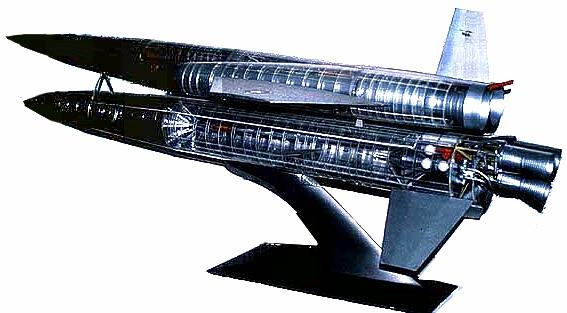
Navaho G-38 Model
Credit: Tom Johnson
AKA: Navaho III;SM-64A;SSM-A-6;W36;WS-104A. Status: Development ended 1958. Payload: 4,500 kg (9,900 lb). Thrust: 1,801.20 kN (404,926 lbf). Gross mass: 131,540 kg (289,990 lb). Height: 65.00 m (213.00 ft). Diameter: 2.37 m (7.77 ft). Span: 12.25 m (40.19 ft). Apogee: 22 km (13 mi).
Development History
North American had been developing a 1600-km range, Mach 3 missile for the US Air Force since March 1946. The vehicle started out as a derivative of the German A9 boost-glide vehicle, but soon developed completely revised aerodynamics, guidance, and improved propulsion. In February 1948 this project was redefined by the customer as only the first step of a revised three-phase program for a family of vehicles using a rocket booster and ramjet cruise. Phase 3 would be the final intercontinental version, carrying a 4500 kg nuclear warhead to an 8000 km range. In order to obtain the necessary accuracy, North American began development of the XN-2 navigation platform, which coupled the XN-1 inertial system with a star tracker to ensure continued accuracy even in long-range flights. In order to achieve the longer ranges, North American began study of a version of the missile, which would use a separate, jettisonable rocket booster. This would allow the cruise stage to be ignited at near-cruise velocity, and to be filled with only ramjet fuel, which would vastly extend the range while the basic cruise missile remained nearly the same size.
By July 1948 the preferred intercontinental Navaho configuration was a delta-winged, recoverable aircraft-type booster looking very much like the B-70 bomber of the 1960's or the reusable boosters of the original space shuttle designs of the 1970's. The cruise stage used a single enormous ramjet engine with a nose intake. By May 1949 North American favored a tandem in-line configuration - a boost stage with a single-ramjet cruise stage atop it. By April 1950, the final Navaho configuration had been settled - a twin-ramjet cruise stage launched strapped to the side of a liquid-rocket booster. This arrangement minimized the length of the vehicle, making handling and erecting on the launch pad easier.
In July 1950, just as the Korean War began, the program was altered yet again. Now the Phase 3 vehicle, dubbed the G-38, would have to carry a 3150-kg 20-kiloton W-4 nuclear warhead over a 10,200 km range. The G-26 phase 2 vehicle, a 2/3 scale version of the G-38, would precede the G-38 in flight test.
Design of the G-38 was begun in 1952. But there were further changes, as the booster fuel was changed from alcohol to kerosene, and the Air Force increased the payload requirement to 4500 kg. These required the vehicle to be somewhat larger than originally planned.
By the time the G-26 pathfinders began flight test in 1956, North American management could see the ballistic missile competition gaining on them. The Thor, Jupiter, Atlas, and Titan development programs were all underway on a crash basis and would begin flight test in 1957. The first tests of the G-26 were dogged with failures - by Independence Day 1957 four launches had been made, all failures. The first in a series of 2,800 km long auto-navigator test flights had been attempted ten times in the first three months of 1957 ever getting off the ground. Wags at the Cape dubbed North America's bird the "Never-Go Navaho". The new ballistic missiles were equally unsuccessful at first, but a Jupiter made a full-range 2100-km flight on 31 May. It was clear that these ballistic missiles, each little more complex than the booster stage of Navaho alone, could deliver a nuclear warhead over the same ranges - at seven times the speed.
Air Force Headquarters terminated the Navaho development program on 12 July 1957. By the end of the month the total staff laid off at North American alone amounted to 15,600 employees. At the time the program was canceled full-range G-38 missiles were in fabrication with first flight test planned by the end of 1958.
Technical Description
The booster followed the same design and layout as that of the G-26, but at 77,140 kg liftoff mass, was 50% larger and equipped with three engines rather than two. The stage was made primarily of 20-24ST aluminum alloy, heliarc-welded and chem-milled between the weld lands. The liquid oxygen tank was forward, the fuel tank aft. Two small fixed separation fins were attached to the intertank structure to ensure the booster would fly away from the cruise stage once released. Aft of the fuel tank was the engine bay, with three gimbaled LR83-NA-1 engines. Two large fixed canted fins were attached to the engine bay, providing vehicle stability during ascent.
The cruise stage had the same fundamental layout as earlier Navahos, but differed substantially in detail. The vehicle had a higher fineness ratio for the increased cruising speed and range. A single slab vertical stabilizer provided yaw control. The trapezoidal wings were completely different from the deltas of the earlier Navahos, with the elevons replaced by independently-moving wingtip elevons for roll control. The full flying canard provided pitch control. At the higher cruise speed and flight duration the G-38 would reach temperatures of 400 deg C. This mandated use of titanium for the nose, wings, and stabilizers. The cruise stage had a mass of 54,400 kg. Its RJ47 ramjets provided 89.26 kN of thrust, allowing the vehicle to cruise at Mach 3.25, reaching an altitude of 21.6 km at the end of mission.
The weapon system would have been guided by an N6B stellar-inertial system and a PIX10 autopilot. The enormous payload bay was sized for one or more nuclear weapons, up to 4500 kg total.
The operational G-38 would have been the first weapon system fielded using all-transistorized avionics and etched circuit boards. The systems were hardened against electromagnetic pulse from nearby nuclear explosions and impervious to jamming. The booster would have produced more thrust than anything America would fly until the Saturn I space booster.
Operationally, missiles would be moved on mammoth transporter-erectors along the interstate highway system (a three-lane road was required) or between shelters on large-area military bases. Missiles on alert status would have the N6B navigation systems operating at all times. This would allow the missile and its support caravan to stop, the missile to be erected, and fired within 30 minutes of a launch order.
Development Cost $: 679.800 million in 1985 dollars. Flyaway Unit Cost 1985$: 24.000 million. Maximum range: 10,200 km (6,300 mi). Number Standard Warheads: 1. Standard warhead: W36. Boost Propulsion: Liquid rocket, 3 x Lox/Kerosene. Cruise Thrust: 89.260 kN (20,066 lbf). Cruise engine: RJ47-W-7. Maximum speed: 3,700 kph (2,200 mph).
Stage Data - Navaho G-38
- Stage 1. 1 x G-38 Navaho Booster. Gross Mass: 76,870 kg (169,460 lb). Empty Mass: 16,780 kg (36,990 lb). Thrust (vac): 2,048.158 kN (460,444 lbf). Isp: 282 sec. Burn time: 90 sec. Isp(sl): 248 sec. Diameter: 2.37 m (7.77 ft). Span: 2.37 m (7.77 ft). Length: 27.43 m (89.99 ft). Propellants: Lox/Kerosene. No Engines: 3. Engine: LR-83-NA-1. Other designations: XB-64A, XSM-64A. Status: Development 1957. Comments: Burns out at altitude 21,600 m, Mach 3. Empty Mass estimated.
- Stage 2. 1 x G-38 Navaho Missile. Gross Mass: 54,648 kg (120,478 lb). Empty Mass: 14,512 kg (31,993 lb). Thrust (vac): 89.260 kN (20,066 lbf). Isp: 1,200 sec. Burn time: 10,300 sec. Diameter: 1.98 m (6.49 ft). Span: 12.25 m (40.19 ft). Length: 26.61 m (87.30 ft). Propellants: Air/Kerosene. No Engines: 2. Engine: RJ47. Other designations: XB-64A, XSM-64A. Status: Development 1957. Comments: Separates from booster at 21,600 m, Mach 3. Mach 3.25 cruise, 10,200 km range, payload 4545 kg in 3.76 m x 1.78 m weapons bay. Empty mass estimated.
Family: ICCM, US Cruise Missiles. Country: USA. Engines: LR83-NA-1, RJ47. Stages: Navaho G-38 AV, Navaho G-38 Booster. Agency: North American.
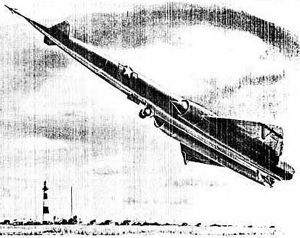 | Navaho G-38 Landing Credit: Tom Johnson |
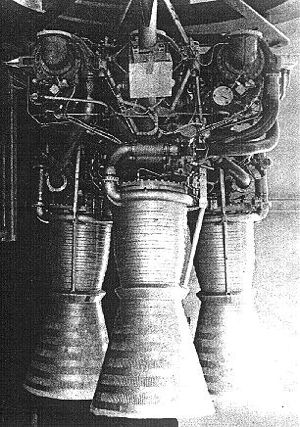 | Navaho G-38 Engine Navaho G-38 3 Engine Cluster |
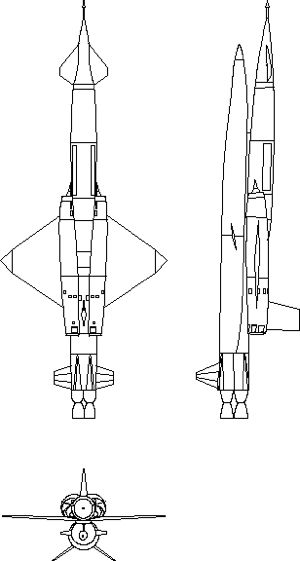 | Navaho G-38 3 View Credit: © Mark Wade |
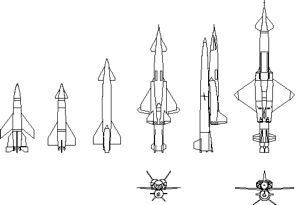 | Navaho development Navaho development sequence Credit: © Mark Wade |
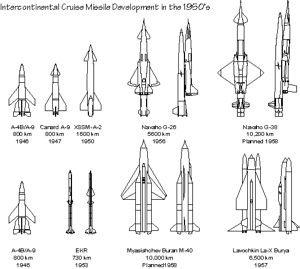 | Navaho vs Burya Credit: © Mark Wade |
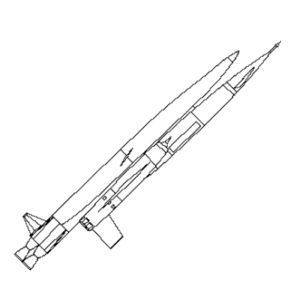 | Navaho G-38 Navaho G-38 160 pixel Credit: © Mark Wade |
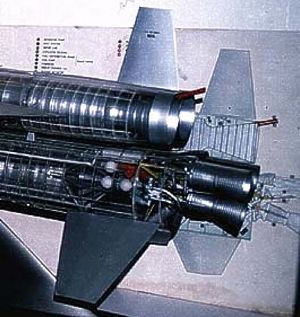 | Navaho G-38 Engine Navaho G-38 Engine Detail Credit: Bob Fortune |
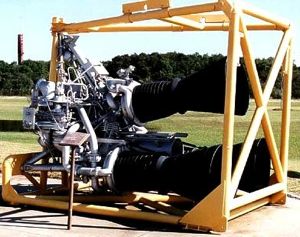 | Navaho G-38 Engine Navaho G-38 Engine Section Credit: Tom Johnson |
1949 May - . LV Family: Navaho. Launch Vehicle: Navaho G-38.
- Intercontinental Navaho - . Nation: USA. Program: Navaho. North American settled on a design for the intercontinental version of the Navaho. It consisted of a tandem in-line boost stage with a single-ramjet cruise stage atop it..
1951 December - . LV Family: Navaho. Launch Vehicle: Navaho G-38.
- Navaho warhead changed - . Nation: USA. Program: Navaho. The missile is to carry the 100-kt W-13 device instead of the 20-kt W-4..
1952 May - . LV Family: Navaho. Launch Vehicle: Navaho G-38.
1954 January 22 - . LV Family: Navaho. Launch Vehicle: Navaho G-38.
- Navaho Weapon System Optimization Study - .
Nation: USA.
Program: Navaho.
Various nuclear warheads were considered for the Navaho. The G-26 would only be capable of carrying the XW-12, XW-5, or XW-13 fission warheads, or the XW-15 thermonuclear device. North American proposed that the production Navaho be enlarged to carry a 4500 kg payload in a 148 inch x 70 inch diameter envelope. This would allow a high-yield thermonuclear device to be carried.
1954 September 22 - . LV Family: Navaho. Launch Vehicle: Navaho G-38.
- Navaho G-38 modified - . Nation: USA. Program: Navaho. Acting on the North American recommendation of January, the Air Force drops the XW-13 warhead for the production Navaho and authorized production of a larger version to carry a 4500-kg warhead..
1955 March - . LV Family: Navaho. Launch Vehicle: Navaho G-38.
1956 June - . LV Family: Navaho. Launch Vehicle: Navaho G-38.
- G-38 booster engine test - . Nation: USA. Program: Navaho. The cluster of three engines produced 1800 kN for 45.5 seconds..
1957 February - . LV Family: Navaho. Launch Vehicle: Navaho G-38.
Back to top of page
Home - Search - Browse - Alphabetic Index: 0- 1- 2- 3- 4- 5- 6- 7- 8- 9
A- B- C- D- E- F- G- H- I- J- K- L- M- N- O- P- Q- R- S- T- U- V- W- X- Y- Z
© 1997-2019 Mark Wade - Contact
© / Conditions for Use